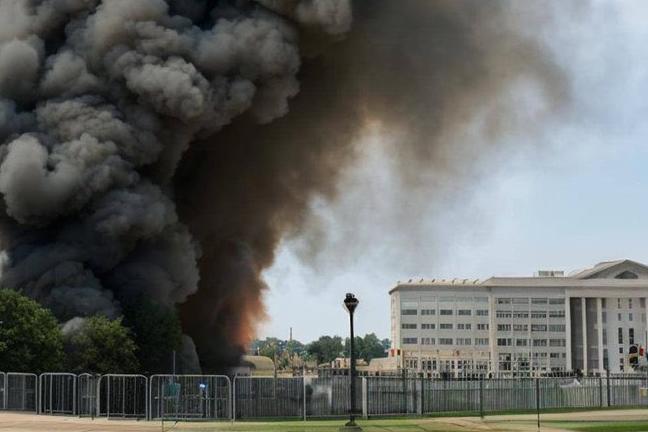The US stock market dropped sharply. Popular investment websites were hit by the widespread circulation of an AI photo purporting to show the moment of an explosion at the Pentagon, located near Washington, D.C.
Were we under attack? It appeared that way to investors. In the early stages of a global conflict, the stock market typically suffers. While gold and treasury bonds rose, the S&P 500 dropped to a session low of its own, down 0.3%.
However, by the end of the day everything was back to normal. Artificial intelligence (AI) experts concluded that the image was fake.
However, the sudden panic among investors raises concerns about the impact of artificial intelligence on the stability of the market, especially as it becomes easier and easier to create convincing phoney images.
Threat of Artificial Intelligence Hoaxes to Algorithmic Trading
There is widespread worry about the downsides of the current AI development boom. Concerns about the spread of false information, the creation of convincing “deep fakes,” and even the potential eradication of humanity have entered the public discourse surrounding this technology.
US Securities and Exchange Commission (SEC) Chairman Gary Gensler warned last month that this technology may represent a “systemic risk” that might lead to the next financial crisis.
Generative artificial intelligence (AI) has a lot of people, including him, worried about the consequences. The Pentagon model is just one example of the complexity that can be generated by generative AI like ChatGPT.
Regulation of the technology is now being worked on by authorities in the United States and the European Union. As long as there isn’t a foolproof method of detecting phoney photographs, the more lifelike and widespread they become, the more of a threat they pose to financial markets.
This is because, as Adam Kobeissi, editor-in-chief of the business website The Kobeissi Letter, explains, market shifts are increasingly in response to breaking news.
He told the Associated Press, “a lot of these moves are happening because of high-frequency trading, algorithmic trading.” Which is to say, in a nutshell, to analyse news stories in order to make a transaction in a fraction of a second based on what you’ve learned.
Algorithmic trading is a form of automated trading in which an algorithm is used to analyse market data in order to predict future price movements based on historical data.
“It’s basically like you’re pulling a trigger every time a headline comes out,” he continued.
The Internet merely amplifies preexisting tendencies.
However, Nir Vulkan, an economics professor at Oxford, argues that such trading practises are nothing new. The market has always been sensitive to hearsay and speculation, but it has a history of being proven right once the facts are known.
The internet makes it more rapid and perhaps more powerful, he told DW, “but it does then correct.”
He disagrees with Kobeissi that algorithmic trading would be the primary driver of volatility in response to the dissemination of bogus images. So why is that? Trading algorithms that execute trades slowly.
Low-frequency trading positions are held for far longer, potentially weeks, than high-frequency trades (which are only held for seconds).
The latter is what hedge funds like. High-frequency algorithms only have a fraction of the trading capital that low-frequency traders do since they focus on short-term possibilities.
In his opinion, “the big money is almost all in low frequency,” Vulkan stated.
The vulnerability of algorithms of sock market may be lower than that of humans
Most of the hedge funds’ algorithms he is familiar with would not react frantically to a short-term move like the one that occurred when the image of the Pentagon attack began to spread. These algorithms wouldn’t be impacted by the self-correcting nature of the move.
“So, you could say that’s fantastic,” he remarked. When it comes to handling temporary false occurrences, “these algorithms are better than people.”
It would be difficult to profit from such fleeting emotions, he argued, unless you either knew they were happening or were responsible for them. That’s against the law as it stands.
But if the prevalence of bogus photos increases, it might cause significant short-term market volatility.
“I don’t know if that’s an algorithmic question,” Vulkan mused. As the author puts it, “that’s more a question about robustness to fake news in general.”
The Dangers of Hoarding AI Technology
Speculators, human or otherwise, falling for AI-generated visuals may not be the biggest threat to the markets right now. Some people worry that people put too much reliance in technology.
Many people have been drawn into the technology stock market in recent months due to the rising popularity of AI. They say that’s too many professionals.
Julian Emanuel of investment advice company Evercore ISI stated on an international channel that “the AI revolution is likely quite real, quite significant.” However, this process occurs in waves. And then your excitement levels rise too high and the stock market crashes.
In a note to clients in April, JPMorgan strategists led by Dubravko Lakos-Bujas claimed that the present level of crowding suggests that “the risk of recession is far from priced in.”
Both analysts are concerned that the success of the index has been driven too much by a small number of businesses in the technology sector, specifically Microsoft, Alphabet, Amazon, Apple, Meta, and Nvidia.
There are currently six companies that account for roughly half of the value of the NASDAQ technology index. An overall market surge could come to an end if sentiment turns against AI or technology in general, as it did after central banks started hiking interest rates.
To read our article about “Apple’s new achievement, a new stock high in 1 week with VR” click here.
